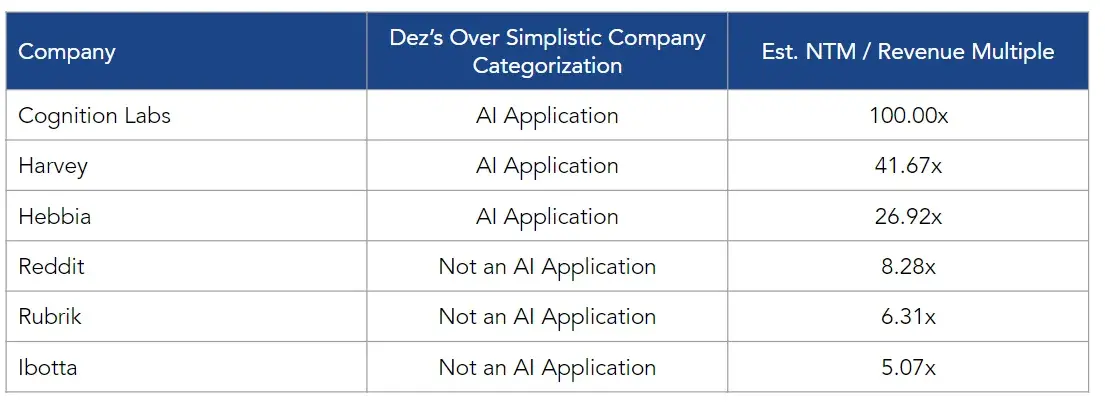The general situation of the venture capital market: intense competition, with returns concentrated in specific areas
Author: DEZ
Compiled by: Shenchao TechFlow
What is the current state of the venture capital industry? If you ask a venture capitalist for their views on the current market, you might hear the following three consistent statements:
A) The market is too crowded
B) Competition is extremely fierce
C) Returns are concentrated at the top.
This is an interesting and consistent commentary, especially considering the key role venture capitalists play in the startup ecosystem. So, is venture capital a dying asset class? Certainly not. But does it face structural challenges? Undoubtedly.
Let’s explore the reasons from a macro perspective.
As of 2024, three notable venture-backed companies have gone public: Reddit, Rubrik, and Ibotta. As of earlier this week, these three companies had enterprise values of approximately $10 billion, $6 billion, and $2 billion, respectively, and are expected to generate revenues of $1.2 billion, $922 million, and $415 million in the next twelve months.
These companies are large, well-capitalized, and well-known, with thousands to millions of loyal users. They have crossed the so-called "chasm" and are striving to become efficiently operating public companies. These billion-dollar success stories are the dreams of venture capitalists, significantly enhancing our careers.
However, despite the fact that returning capital is the only thing that truly matters to venture capitalists in the long run, we (as an industry) are still very willing to suspend disbelief when it comes to the core part of our work—pricing.
In recent weeks, the early startup environment has continued to differentiate into two types: AI-native companies and all other companies.
AI-native companies focus on applications, reasoning, and cutting-edge/deep technology model layers. Companies like Hebbia recently raised financing at a valuation of $700 million, Cognition Labs is now valued at $2 billion (incredibly just six months later), and Harvey is reportedly nearing a funding round with a valuation of $1.5 billion.
In fact, we do not live in an environment where these valuations are rare. In reality, they are quite common. Other companies like Glean (valuation of $2 billion), Skild AI (valuation of $1.5 billion), and Applied Intuition (valuation of $6 billion) are also reinforcing this trend. I have particular insight into Hebbia, Cognition, and Harvey, which have several advantages:
They are making money: Hebbia reportedly has $13 million in revenue and is profitable, Cognition's revenue may be between $5 million and $10 million, and Harvey's revenue exceeds $20 million.
They are building brand and talent density for themselves: If you look at their employee composition, you'll find many Ivy League graduates and tech veterans.
They have well-known brand clients: such as PwC, KKR (Kohlberg Kravis Roberts & Co.), T-Mobile, Bridgewater Associates, the U.S. Air Force, Centerview Partners, etc.
They represent a generational shift in application software: focusing more on outcomes rather than workflows (i.e., don’t help me do the work, do the work for me directly).
However, despite the questionable unicorn valuations, they are all firmly in the "chasm." There is no guarantee that they will survive to see the day they go public. The competition in this field is extremely fierce. The technologies they are building may plateau and fail to provide sufficiently clear returns on investment for their end customers. Moreover, their public company peers are 20 times larger in revenue scale, having clearly established themselves as market leaders, and are valued at 5 to 8 times their revenue for the next 12 months, rather than the 20 to 100 times future revenue valuations.
This is the structural challenge facing the venture capital industry: excess capital, but a scarcity of quality investable assets, leading to unsustainable valuation increases that ultimately harm equity value. However, among these crazy valuations, some may appear relatively cheap in hindsight. Today, there are indeed some real, lasting, generational companies being built; it’s just that no one can clearly discern which companies will become Webvan and which will become Doordash.
(Note: It is very difficult to predict which companies will ultimately fail and which will achieve great success.
Webvan: An online grocery delivery company founded in 1999, which ultimately went bankrupt in 2001 due to mismanagement and underestimating market demand. Webvan is often cited as a typical example of startup failure.
Doordash: An online food delivery platform founded in 2013 that rapidly expanded and successfully went public in 2020, becoming a multi-billion dollar company. Doordash is a typical representative of startup success.)
Companies like Doordash have provided substantial returns to their investors, which in turn has sparked a new round of interest in venture capital as an asset class. This cycle continues to repeat, and by 2040, we may be discussing a new investment technology that will also exhibit similar price distortions. This is the current state of venture capital. To further clarify this, I believe there are several themes about the state of venture capital that are very clear:
- We are in a low liquidity period, near the bottom of the market cycle. 2022 was the year with the fewest IPOs since the global financial crisis, and 2023 has shown no significant improvement.

- Application software has been a continuous gift, accounting for 8% of all IPOs since 1996, but it is maturing as a venture capital sub-industry. Given this, the investable market opportunities are shrinking.

- Venture capital has never been so competitive. Over the past 20 years, the venture capital asset class has grown more than fourfold. This reflects the idea that "your margin is my opportunity."

- For assets considered unique, price is no longer a consideration. 100 times revenue multiples are accepted and increasingly common.

If I had to simplify my core argument, it is that when you turn $7 million into $4 billion, it tends to attract competition, and competition is the defining factor of the current state of venture capital. Pricing, deal velocity, and the intensity of the deal process—all stem from competition, and the competitive dynamics in today’s venture capital landscape are well illustrated by "the tale of two cities"; currently, there are AI-native companies and all other companies.
Now the real question is, if this is the state of venture capital, then what? I have my own thoughts and strategies being implemented, but I will reserve those for now. In the meantime, I wish everyone a pleasant week and successful investing.
To avoid any doubt, I have not spoken directly with these companies. This data is an estimate I have gathered from public records and private conversations.
It should be noted that I am not saying these are prerequisites for success, but they are strong early indicators of talent density.









